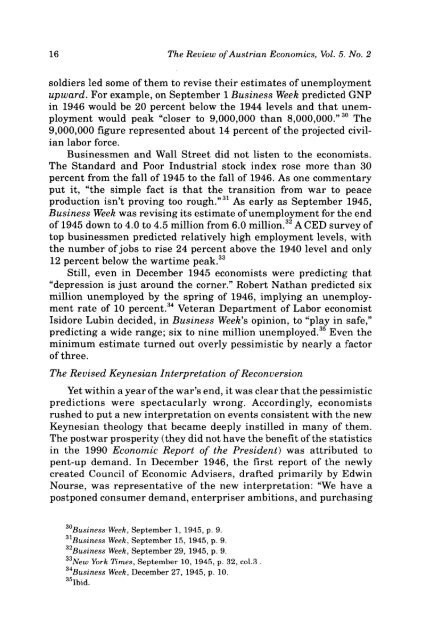Review of Austrian Economics - The Ludwig von Mises Institute
Review of Austrian Economics - The Ludwig von Mises Institute
Review of Austrian Economics - The Ludwig von Mises Institute
You also want an ePaper? Increase the reach of your titles
YUMPU automatically turns print PDFs into web optimized ePapers that Google loves.
16 <strong>The</strong> <strong>Review</strong> <strong>of</strong> <strong>Austrian</strong> <strong>Economics</strong>, Vol. 5. No. 2<br />
soldiers led some <strong>of</strong> them to revise their estimates <strong>of</strong> unemployment<br />
upward. For example, on September 1 Business Week predicted GNP<br />
in 1946 would be 20 percent below the 1944 levels and that unemployment<br />
would peak "closer to 9,000,000 than 8,000,000." 30 <strong>The</strong><br />
9,000,000 figure represented about 14 percent <strong>of</strong> the projected civilian<br />
labor force.<br />
Businessmen and Wall Street did not listen to the economists.<br />
<strong>The</strong> Standard and Poor Industrial stock index rose more than 30<br />
percent from the fall <strong>of</strong> 1945 to the fall <strong>of</strong> 1946. As one commentary<br />
put it, "the simple fact is that the transition from war to peace<br />
production isn't proving too rough." 31 As early as September 1945,<br />
Business Week was revising its estimate <strong>of</strong> unemployment for the end<br />
<strong>of</strong> 1945 down to 4.0 to 4.5 million from 6.0 million. 32 A CED survey <strong>of</strong><br />
top businessmen predicted relatively high employment levels, with<br />
the number <strong>of</strong> jobs to rise 24 percent above the 1940 level and only<br />
12 percent below the wartime peak. 33<br />
Still, even in December 1945 economists were predicting that<br />
"depression is just around the corner." Robert Nathan predicted six<br />
million unemployed by the spring <strong>of</strong> 1946, implying an unemployment<br />
rate <strong>of</strong> 10 percent. 34 Veteran Department <strong>of</strong> Labor economist<br />
Isidore Lubin decided, in Business Week's opinion, to "play in safe,"<br />
predicting a wide range; six to nine million unemployed. 35 Even the<br />
minimum estimate turned out overly pessimistic by nearly a factor<br />
<strong>of</strong> three.<br />
<strong>The</strong> Revised Keynesian Interpretation <strong>of</strong> Reconversion<br />
Yet within a year <strong>of</strong> the war's end, it was clear that the pessimistic<br />
predictions were spectacularly wrong. Accordingly, economists<br />
rushed to put a new interpretation on events consistent with the new<br />
Keynesian theology that became deeply instilled in many <strong>of</strong> them.<br />
<strong>The</strong> postwar prosperity (they did not have the benefit <strong>of</strong> the statistics<br />
in the 1990 Economic Report <strong>of</strong> the President) was attributed to<br />
pent-up demand. In December 1946, the first report <strong>of</strong> the newly<br />
created Council <strong>of</strong> Economic Advisers, drafted primarily by Edwin<br />
Nourse, was representative <strong>of</strong> the new interpretation: "We have a<br />
postponed consumer demand, enterpriser ambitions, and purchasing<br />
^Business Week, September 1, 1945, p. 9.<br />
31 Business Week, September 15, 1945, p. 9.<br />
^Business Week, September 29, 1945, p. 9.<br />
33 New York Times, September 10, 1945, p. 32, col.3 .<br />
^Business Week, December 27, 1945, p. 10.<br />
35 Ibid.

















